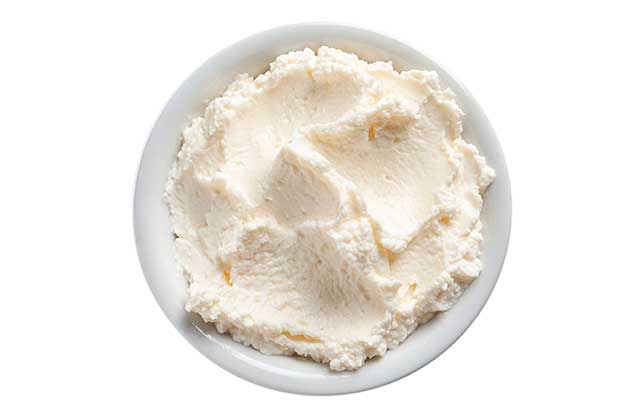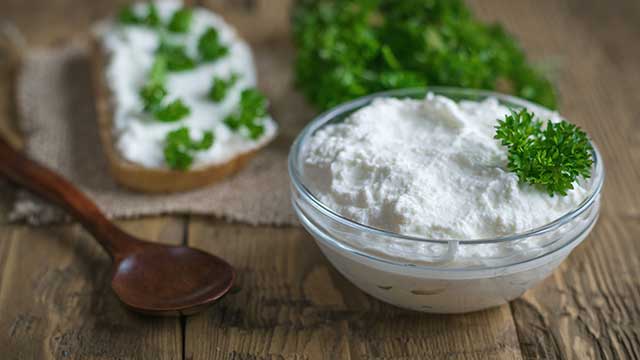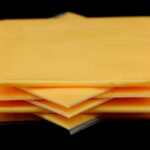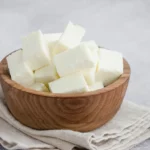Cream cheese is a delicious and versatile fresh cheese product.
Interestingly, it is a traditional food too, and it has origins going back to 1583 in the United Kingdom.
However, cream cheese is quite different from regular cheese.
In this article, we take a look at the ingredients it contains and its nutritional properties.
Is cream cheese a healthy choice?
How Is Cream Cheese Made?

First of all, the production process of cream cheese is relatively straightforward.
The Wisconsin Center for Dairy Research explains the process in their guide.
In short, the main production steps are below;
- First of all, regular milk goes through a pasteurization and homogenization process.
- After this, producers add a starter cheese culture to the milk.
- The mixture then undergoes an acidification process. This process involves adding a source of acid, such as acetic acid (the main component of vinegar).
- Once the mixture thickens, the manufacturers remove some of the excess moisture via centrifugation or ultrafiltration.
- After this, the cream cheese is ready for packing.
However, not all cream cheese products use the same ingredients, which can differ from brand to brand.
Ingredients In Popular Cream Cheese Brands
The ingredient profile of cream cheese can vary.
While some products contain minimal ingredients, others may include a range of additives.
However, it is worth noting that just because food has undergone greater processing doesn’t necessarily mean it is a “bad” option. Many versions of cream cheese and other processed cheese products (such as string cheese) are very close to regular cheese nutritionally.
To see how these products can differ, here are the ingredient profiles for five of the most popular brands.
1) Philadelphia Cream Cheese (Original)
Philadelphia is the world’s most popular cream cheese, and you can find it in all corners of the globe.
However, the ingredients depend on whether you buy the ‘brick’ or the spread product.
Philadelphia “Brick” Ingredients
- Pasteurized milk
- Cream
- Salt
- Carob Bean Gum
- Cheese Culture
This cream cheese contains four simple ingredients in addition to a thickening gum.
Philadelphia “Spread” Ingredients
- Pasteurized milk and cream
- Whey protein concentrate
- Salt
- Carob Bean Gum
- Xanthan Gum
- Guar Gum
- Natamycin
- Vitamin A Palmitate
- Cheese Culture
The various gums in this product work as thickeners, and natamycin (E235) is a mold inhibitor (1).
2) Arla Cream Cheese
Arla Foods is a Danish company, yet they operate and sell their products around the world.
Arla’s product is made from only four simple ingredients;
- Milk
- Cream
- Lactic Acid
- Salt
3) Gina Marie
Gina Marie is a US-based company that makes a wide range of cultured dairy products.
Their original ‘Old Fashioned’ cream cheese contains the following ingredients;
- Cultured Milk
- Cream
- Sea Salt
4) Nancy’s Cream Cheese
Nancy’s cream cheese is a Swiss product that we can find in Whole Foods stores.
Positioned as a healthier product, this spread contains a variety of probiotics.
Here are the ingredients;
- Organic Cream
- Organic Non-Fat Milk
- Salt
- 4 Strains of Lactic Probiotic Cultures
5) Organic Valley Cream Cheese
Organic Valley is one of the world’s more prominent dairy companies, and they serve numerous countries around the world.
Similar to Philadelphia, Organic Valley cream cheese ingredients differ between the “brick” and spread.
Organic Valley “Brick” Cream Cheese
- Organic Milk
- Organic Cream
- Cheese Culture
- Salt
- Locust Bean Gum
Organic Valley Cream Cheese Spread
- Organic Milk
- Organic Cream
- Whey
- Cheese Culture
- Salt
- Locust Bean Gum
Nutrition Facts
Firstly, the nutritional values will slightly differ depending on the specific product and brand.
However, each option will be reasonably similar.
The tables below show the full nutrition profile for regular cream cheese per 100 grams (3.5 oz) (2).
| Calories/Nutrient | Amount |
|---|---|
| Calories | 342 kcal |
| Carbohydrate | 4.1 g |
| Fiber | 0.0 g |
| Sugar | 3.2 g |
| Fat | 34.2 g |
| Saturated Fat | 19.3 g |
| Monounsaturated Fat | 8.6 g |
| Polyunsaturated Fat | 1.4 g |
| Omega-3 Fatty Acids | 173 mg |
| Omega-6 Fatty Acids | 1032 mg |
| Protein | 5.9 g |
As shown, cream cheese contains much higher amounts of fat (and lower protein) than regular cheese.
The omega-3 and omega-6 ratios will also depend on the feed of the animals that produce the milk.
| Vitamin | Amount | % DV |
|---|---|---|
| Vitamin A | 362 mcg RAE | 40.2 % |
| Riboflavin (B2) | 0.1 mg | 7 % |
| Pantothenic Acid (B5) | 0.6 mg | 6 % |
| Vitamin B12 | 0.3 mcg | 4 % |
| Vitamin K | 3.4 mcg | 4 % |
| Folate | 11.0 mcg | 3 % |
| Vitamin E | 0.7 mg | 3 % |
| Vitamin B6 | Trace | 2 % |
| Thiamin (B1) | Trace | 1 % |
| Niacin (B3) | 0.1 mg | 1 % |
| Mineral | Amount | % DV |
|---|---|---|
| Sodium | 321 mg | 13 % |
| Phosphorus | 106 mg | 11 % |
| Calcium | 98.0 mg | 10 % |
| Potassium | 138 mg | 4 % |
| Selenium | 2.4 mcg | 3 % |
| Zinc | 0.5 mg | 3 % |
| Iron | 0.4 mg | 2 % |
| Magnesium | 9.0 mg | 2 % |
| Copper | Trace | 1 % |
| Manganese | Trace | 1 % |
Benefits

Cream cheese does not provide a lot of nutritional benefits in comparison to regular cheese.
However, here are some of the advantages it does offer.
1) Excellent Source of Vitamin A (Retinol)
Cream cheese offers good concentrations of vitamin A in its most bioavailable form: retinol.
Since it contains 362 mcg of retinol activity equivalents, cream cheese provides over 40% of the recommended intake per 100 grams.
Vitamin A is an essential fat-soluble vitamin, and it has many vital roles in the body.
Among its functions, vitamin A is important for (3);
- Optimal immune function
- Vision
- Regulating genes
- Healthful growth and development
- Skeletal health
2) Tasty and Versatile
Another great benefit of cream cheese is the taste; with a mild, creamy, and cheesy flavor, it tastes delicious.
The cheese is also very versatile, and we can use it in many different ways for a variety of recipes.
Similar to regular cheese, just a little serving can enhance the flavor of most dishes.
Drawbacks
While there is nothing outrightly “bad” about cream cheese, it does have some potentially negative points.
1) Cream Cheese Is Not As Nutritious As Regular Cheese
Regular cheese is a concentrated form of milk, and as time passes, bacteria digest the milk sugars.
As a result, cheese provides little carbohydrate and very high amounts of fat, protein, and all the nutrients in regular milk in a small package.
However, cream cheese, which is a fresh combination of cultured milk and cream, is mainly a source of fat and calories.
Furthermore, since it does not ferment for long, it doesn’t offer the concentrated source of nutrients that hard cheeses like Parmesan cheese and Cheddar provide.
To illustrate this, the table below shows how Cheddar cheese and cream cheese nutritionally differ per 100 grams (2, 4);
| Nutrient | Cheddar Cheese | Cream Cheese |
|---|---|---|
| Calories | 403 kcal | 342 kcal |
| Carbohydrate | 1.3 g | 4.1 g |
| Fat | 33.1 g | 34.2 g |
| Protein | 24.9 g | 5.9 g |
| Calcium | 72 % DV | 10 % DV |
| Phosphorus | 51 % DV | 11 % DV |
2) Dairy Allergies
Dairy allergies can prevent people from enjoying cheese, milk, yogurt, or any other type of dairy product.
Since cream cheese is a form of fresh dairy, it contains more milk sugars (lactose) than hard cheese.
For this reason, the product may be problematic for individuals with lactose intolerance (5, 6).
Lactose intolerance affects an estimated 65% of the global population and afflicts more than 90% of some East Asian communities. However, it is less of a problem for those of Northern European ancestry, affecting around 5-10% of people (7).
In addition to lactose intolerance, milk protein allergy can also be a problem (8).
Cream cheese does not contain a lot of protein, but it still contains enough to be problematic for people with severe allergies or sensitivities.
Is the Saturated Fat Content In Cream Cheese Harmful?
Some people worry about the high saturated fat content of cream cheese.
The reason for this is that certain saturated fatty acids can raise plasma levels of LDL cholesterol (LDL-C) (9).
Furthermore, research suggests that LDL-C is associated with cardiovascular risk (10).
However, numerous systematic reviews—looking at the totality of the evidence—demonstrate that dairy products have a neutral or inverse impact on cardiovascular risk (11, 12, 13, 14).
In other words; if cheese consumption is a cardiovascular risk, there is currently little evidence to support this assertion.
While it probably isn’t a good idea to binge on cream cheese (which would displace more nutritious foods), there are no reasons to worry about reasonable serving sizes.
Should We Worry About Thickening Gums In Cream Cheese?
As we saw in the ingredients section of this guide, some cream cheese products use various thickeners.
Some of the more common thickening ingredients include;
- Carob bean gum
- Guar gum
- Xanthan
However, it is worth remembering that the doses of these ingredients are extremely low.
Studies also appear to show that these additives are reasonably safe. However, as a type of fiber, they can potentially cause gastrointestinal distress for some individuals (15, 16).
Furthermore, not all cream cheeses use these ingredients, and it is easy to buy products with more simple ingredient profiles that don’t.
Ways To Use Cream Cheese
When people think about cream cheese, foods like crackers or bagels may also come to mind.
However, there are numerous ways to use this spread.
1) With Potatoes
Baked potatoes with cream cheese is a classic combination that many people enjoy.
For an even tastier option, try adding some chopped up bacon and fresh chives.
2) To Thicken Sauces
Cream cheese is thick and creamy, and it can lend those qualities to any sauce.
Try adding a little to a sauce to thicken it up (and give it a mild cheesy flavor).
3) Cream Cheese Sushi Rolls
Cream cheese works well in sushi rolls, particularly alongside salmon.
For people watching their carb intake, some people even omit the rice in favor of cream cheese for a low-carb, high-fat meal.
4) As a Butter Replacement
Butter is delicious, but cream cheese is just as tasty, if not more so.
On this note, we can use the spread in the same way as we use butter.
Melting some cream cheese on top of vegetables offers the same benefits regarding better absorption of fat-soluble vitamins, and it tastes delicious too.
5) In Soups and Stews
Adding cream cheese to any soup or stew is a simple way to enhance the flavor dramatically.
For a tasty example, see this beef and cream cheese stew.
6) Making a Dip
Dips can make a great combination with all kinds of food. However, most store-bought options are full of unhealthy oils.
For a simple and tasty dip, combine some cream cheese with a bit of sour cream and vegetables.
Here is a sample recipe idea;
- 4 oz (113 g) cream cheese
- 4 oz (113 g) sour cream
- 1 tbsp finely chopped chives
- ½ tsp garlic powder
- 1 tsp salt
Final Thoughts
Cream cheese is delicious, but it is not the most nutritious food in the world.
That said, it does offer some nutritional benefits, and it adds a whole host of flavor to our food.
Overall, cream cheese can be a tasty addition to any diet. However, hard aged cheese is a better option nutritionally.
For more cheese articles, see this guide to Stilton – one of the best blue cheeses.








